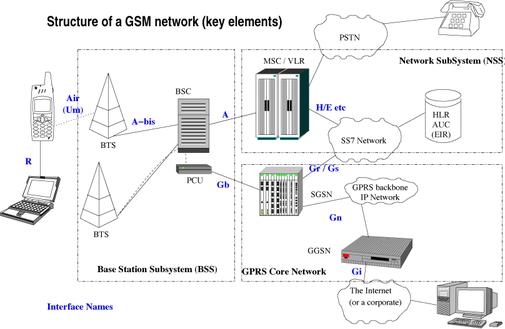Hi this is about the evolution in GSM Technology for data transfers.
From a radio access perspective, adding 3G capabilities to 2G systems mainly means supporting higher data rates. Possible scenarios depend on spectrum availability for the network service provider. Depending on the spectrum situation, two different migration paths can be supported:
Reframing of existing spectrum bands
New or modified spectrum bands

Two 3G radio access schemes are identifi ed to support the different spectrum scenarios:
1. Enhanced data rates for GSM evolution (EDGE) with high-level modulation in a 200 kHz TDMA channel is based on plug-in transceiver equipment, thereby allowing the migration of existing bands in small spectrum segments.
2. Universal mobile telecommunications services (UMTS) is a new radio access network based on 5 MHz WCDMA and optimized for effi cient support of 3G services. UMTS can be used in both new and existing spectra.
From a network point of view, 3G capabilities implies the addition of packet switched (PS) services, Internet access, and IP connectivity. With this approach, the existing mobile networks reuse the elements of mobility support, user authentication service handling, and circuit switched (CS) services. With packet switched services, IP connectivity can then be added to provide a mobile multimedia core network by evolving the existing mobile network.
GSM is moving to develop enhanced cutting-edge, customer-focused solutions to meet the challenges of the new millennium and 3G mobile services [29]. When GSM was fi rst introduced, no one could have predicted the dramatic growth of the Internet and the rising demand for multimedia services. These developments have brought about new challenges to the world of GSM. For GSM operators, the emphasis is now rapidly changing from that of instigating and driving the development of technology to fundamentally enabling mobile data transmission to that of improving speed, quality, simplicity, coverage, and reliability in terms of tools and services that will boost mass market take-up.
Users are increasingly looking to gain access to information and services wherever they are and whenever they want. GSM should provide that connectivity. Internet access, web browsing and the whole range of mobile multimedia capability are the major drivers for development of higher data speed technologies. Current data traffi c on most GSM networks is modest, less than 5% of total GSM traffi c. But with the new initiatives coming to fruition during the course of the next two to three years, exponential growth in data traffi c is forecast. The use of messaging-based applications may reach up to about 90% by the year 2008. GSM data transmission using high-speed circuit switched data (HSCSD) and GPRS may reach a penetration of about 80% by 2008 [1]. GSM operators have two nonexclusive options for evolving their networks to 3G wideband multimedia operation: (1) using GPRS and EDGE in the existing radio spectrum, and in small amounts of the new spectrum; or (2) using WCDMA in the new 2 GHz bands, or in large amounts of the existing spectrum. Both approaches offer a high degree of investment fl exibility because roll-out can proceed in line with market demand with the extensive reuse of existing network equipment and radio sites.
In the new 2 GHz bands, 3G capabilities are delivered using a new wideband radio interface that offers much higher user data rates than are available today — 384 kbps in the wide area and up to 2 Mbps in the local area. Of equal importance for such services is the high-speed packet switching provided by GPRS and its connection to public and private IP networks.
GSM and digital (D)AMPS (IS-136) operators can use existing radio bands to deliver some of the 3G services, even without the new wideband spectrum by evolving current networks and deploying GPRS and EDGE technologies. In the early years of 3G service deployment, a large proportion of wireless traffic will still be voice-only and low-rate data. So whatever the ultimate capabilities of 3G networks, effi cient and profi table ways of delivering more basic wireless services are still needed.
The significance of EDGE for today’s GSM operators is that it increases data rates up to 384 kbps and potentially even higher in a good quality radio environment using current GSM spectrum and carrier structures more efficiently. EDGE is both a complement and an alternative to new WCDMA coverage. EDGE also has the effect of unifying the GSM, D-AMPS and WCDMA services through the use of dual-mode terminals.


 8:10 AM
8:10 AM
 deli
deli
0 comments:
Post a Comment